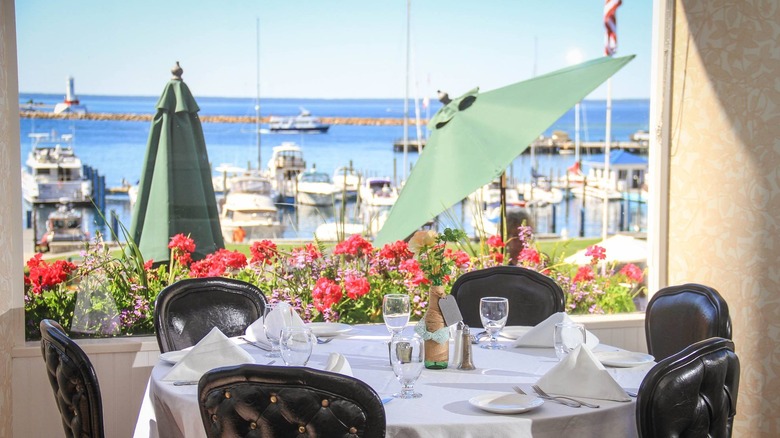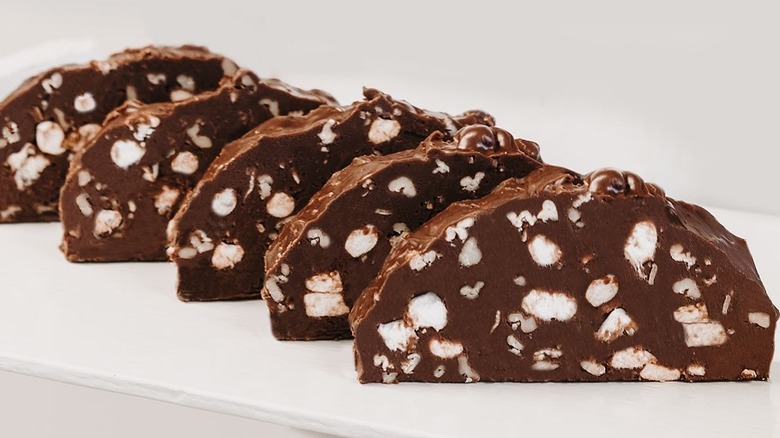Hidden Between Michigan's Upper And Lower Peninsulas, This Island Is Famous For Fudge And Fine Dining
A Michigan island attracts foodies, adventurous travelers, and upscale vacationers alike. Located on Lake Huron between Michigan's upper and lower peninsulas, Mackinac Island provides many activities for travelers looking for a break from the mainland, and its offerings can be partially credited to its ostentatious Victorian-era roots that lured in wealthy families searching for a luxurious summer vacation. As the island gained popularity, hotels and homes sprang up, making Mackinac Island an even more ideal resort destination.
Mackinac is home to around 30 restaurants, bars, and hotels in a 3.8 square mile footprint, with 82% of the island dedicated to Mackinac Island State Park. While the island is famed for its fudge (sold in over a dozen shops downtown), it offers far more than sweet treats; part of its gastronomic lineup includes renowned fine dining establishments serving locally caught fish and filet mignon. Whether you're a lover of sweets or a fine dining aficionado, Mackinac Island presents a feast for the senses.
Mackinac Island's historic fudge
Before fudge took off as Mackinac Island's favorite candy over 100 years ago, Native American maple sugar was its residents' sweet of choice. It wasn't until Rome Murdick and his family opened Murdick's, the island's oldest candy shop, in 1887, that fudge became prevalent on the island. Murdick took a theatrical approach to fudge making. Facing the street-side window, he spread his fudge on a marble counter with a metal trowel. This move attracted passersby, developing the island's culture of showcasing fudge making and leading to more visitors, who began to associate Mackinac with sweets.
Fudge lost popularity during the economic downturn and sugar shortages of the Great Depression and World Wars I and II, forcing several shops to shut down for good. Fudge ultimately made a comeback in the mid-20th century as the country's growing economy and expanded infrastructure made it easier to visit the island. The candy has become such a fundamental part of the visitor experience that tourists are nicknamed "fudgies."
Today, you'll find 14 fudge shops in downtown Mackinac, which, during peak tourist season, produce over 10,000 pounds of fudge per day. Though you might think fudge is pretty straightforward (once you've tried one, you've tried them all), Mackinac fudge shops like Joann's prove this is not the case. With up to 30 delicious flavors available daily, it's nearly impossible to try the entirety of the island's varied selection. (And if you're now seriously craving fudge, try our recipe for easy two-ingredient fudge, or better yet, take things up a notch with pumpkin and pecan vanilla fudge.)
Mackinac Island is a hub for fine dining
Fine dining is also important to Mackinac Island, with 1852 Grill Room and Woods Restaurant serving some of the highest-rated fare on the island. The restaurant offers an alluring view of the surrounding water, combined with dinner entrees ranging from filet mignon to white clam linguini. Meanwhile, Woods Restaurant welcomes visitors with its sophisticated Bavarian-style decor and hearty dishes, including herb-crusted elk rack and locally-sourced seared lake trout.
Carriage House is another fine-dining restaurant in the neighborhood and serves refined delicacies like Royal Ossetra caviar and pan seared diver scallops in a waterfront setting. The establishment proudly sources much of its produce from regional organic farmers. Additionally, the eatery acquires its seafood locally from Lake Superior and obtains quality cuts of meat such as Berkshire pork chops and New York Strip from a Detroit butcher.
After a day of hiking, horseback riding, or cycling around the island, a top-grade meal paired with a refreshing glass of wine is a bonus. And if you're a foodie looking to expand your Michigan vacation, consider heading to the state's capital next. From Coney dogs to bumpy cake, there are plenty of classic Detroit foods worth trying.


